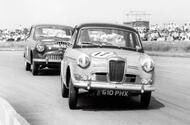Why Did Early British Touring Car Racing Capture So Many Hearts?
If you’ve ever watched a modern British Touring Car Championship (BTCC) race, you know the thrill—door-to-door action, familiar cars, and an atmosphere that feels more like a festival than a sporting event. But wind the clock back to the early days, and you’ll find that the magic was there from the start. What made those first races so captivating? It was the simple, relatable idea: ordinary cars, the kind you might see on your own street, battling it out at breakneck speeds.
Back in 1952, Britain’s first proper touring car race was a revelation. Unlike the exotic machines of Formula One, these were cars you could actually buy (at least, if you had the cash and could find one in postwar Britain). The British Racing Drivers’ Club split their annual Silverstone event into two: one for sports cars, one for touring cars. The result? A spectacle that felt accessible, authentic, and utterly unpredictable.
What Sparked the Creation of the British Saloon Car Championship?
As the popularity of these races soared, it was only a matter of time before someone had the bright idea to turn them into a full-blown championship. Enter Ken Gregory, secretary of the British Racing and Sports Car Club and a director at Brands Hatch. Gregory saw the potential for a series that would pit showroom-spec cars against each other, but with a clever twist: to keep things fair, cars were divided into four classes based on engine size. This meant a tiny Austin A35 could chase glory just as much as a burly Jensen 541.
The first official championship event took place at Brands Hatch in April 1958, following a successful trial run the previous Boxing Day. The format was simple but effective—multiple classes, close racing, and a points system that rewarded consistency as much as outright speed.
How Did the Early Races Unfold—and Who Were the Standout Drivers?
The early years of the championship were anything but predictable. Sure, there were favorites—Jack Sears in his Austin A105, Tommy Sopwith in the Jaguar 3.4—but the real drama came from the class battles. In the sub-1200cc category, for example, George ‘Doc’ Shepherd and John Sprinzel waged a race-long duel, swapping places and pushing each other to the limit. Meanwhile, in the bigger classes, the Jaguars often led the way, their drivers cornering so hard they were said to be “on the door handles.”
But it wasn’t just about the winners. The championship quickly became a proving ground for up-and-coming talent and a showcase for clever engineering. Tommy Bridger, for instance, made waves (and maybe a few enemies) by taking the 1200-1600cc class in a German Borgward Isabella, using its superior cornering to outfox the competition.
What Made the Racing So Unpredictable and Entertaining?
Part of the appeal was the sheer variety of cars and drivers. You’d see everything from nimble Austins to hulking Jaguars, all sharing the same track. And because the rules allowed only minimal modifications—mostly for safety and reliability—success often came down to driver skill and a bit of luck.
There were plenty of wild moments, too. At Mallory Park, Harold Grace flipped his Riley 1.5 into a ditch and walked away unharmed—a testament to the toughness of both car and driver. And when the championship reached its climax, the title fight was so close that Sears and Sopwith ended the season tied on points. The solution? A dramatic head-to-head shootout in identical Riley 1.5s, with Sears edging out Sopwith by just 1.6 seconds in pouring rain.
How Did These Early Days Shape the BTCC We Know Today?
The DNA of those first races is still visible in the BTCC’s modern incarnation. The emphasis on close, competitive racing with cars that look like what’s in your driveway remains a cornerstone of the series. The class system, designed to give underdogs a shot at glory, set a precedent for fairness and excitement that persists to this day.
What’s more, the BTCC’s early years helped cement Britain’s reputation as a hotbed for motorsport innovation. Manufacturers quickly realized the marketing value of success on Sunday translating to sales on Monday. According to the Society of Motor Manufacturers and Traders, motorsport involvement has long been linked to increased brand loyalty and sales, a trend that began in earnest with these early touring car battles.
What Can Modern Racing Fans Learn from the Past?
If there’s one lesson from the early days of British touring car racing, it’s that you don’t need the fastest or most expensive car to make history. Sometimes, it’s the plucky underdog, the clever strategist, or the driver who simply refuses to give up that captures the crowd’s imagination.
And maybe that’s why, seventy years on, the BTCC still packs grandstands and draws millions of viewers. It’s not just about horsepower or high-tech wizardry. It’s about the thrill of competition, the unpredictability of sport, and the joy of seeing cars you recognize doing extraordinary things.
So next time you watch a touring car race, spare a thought for those early pioneers—the drivers who braved the rain, the mud, and the odd overturned Riley to give us one of motorsport’s most enduring spectacles. Their spirit lives on in every close finish and every daring overtake. And honestly, that’s what keeps us coming back for more.

